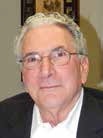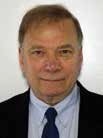Industry Analysis - Four guys discuss molecular imaging
June 15, 2015
by Philip F. Jacobus, CEO
At the end of April, I had dinner with three people at Nino’s Restaurant in New York City. Nino’s is popular with celebrities and the owner, Nino Selimaj, is friends with many of them. Personally, I felt like I was among celebrities from our industry, as I shared a table with three people deeply grounded in molecular imaging.
In attendance were Dr. Stanley Goldsmith (who recommended Nino’s restaurant), James Reiss, and Don Bogutski. Goldsmith is the past president of the Society of Nuclear Medicine and has been actively involved with the society for more than four decades, and he is also Director-Emeritus and Professor of Radiology and Medicine at Weill Cornell Medical College. Reiss is the president of Biodex Medical Systems, which manufactures molecular imaging accessories.
In three days Biodex turns raw steel into finished products and ships them to 85 countries around the world. Last, but certainly not least, Bogutski has been the president of Diagnostix Plus, a supplier of molecular imaging capital equipment, for 32 years. As you can imagine, we talked about a number of very interesting topics related to molecular imaging.
Iodine
Goldsmith talked about an article that he once wrote on the role of radioiodine in diagnostic imaging and targeted radionuclide therapy. I will not go into details here because I am hoping that we can convince him to share it with us, but it is a very interesting analysis of the role that iodine has played in health care over the years.
A shift in tradition
The main topic of conversation focused on the future of the molecular imaging sector. For instance, there is a trend nowadays on the part of radiologists to interpret molecular imaging studies. Some cynics would say this is to generate additional income opportunities.
Physicians who are seeking designation as Authorized Users, which would enable them to use radio-nuclides for therapy, can do so now based on the observation of just 6 cases. Goldsmith believes more experience (perhaps 50 cases) is appropriate to better appreciate eligibility criteria, dose selection and patient management. He believes it is vital for physicians to get that level of training in molecular imaging because the discussion and intricacies of each individual case serves to give a professional a better understanding of what to look for and what to disregard when it comes to interpreting images.
From there we discussed the move away from patient-specific medicine to disease specific medicine and the idea that scanning has become almost automatic. There is even a joke that has circulated that after looking at an image, the reader states: “We better examine the patient!”
Everyone at the table agreed that PET images lead to better patient outcomes and the general prediction is that although PET is well developed in the U.S., its adoption has been fairly slow beyond our borders, but it will continue to grow internationally as more studies are conducted showing its benefits. Reiss said that he has seen growth in PET centers, both inside and outside the U.S.
Promising developments
We also discussed cancer genome sequencing. Using this technology to study the genes of the cancer cell, medical professionals can determine the type of cancer and track how the cancer is reacting to treatment. This enables them to make adjustments to the therapy regime quickly and effectively. With this information, it may be possible in the future to program the cancer cells to basically commit cellular suicide, or apoptosis, via the introduction of a special radiopharmaceutical cocktail. Right now, things are still in the research stage, so it may be some time before results are in and the cost is something manageable for wide application.
The concept of gene sequencing led to a conversation with Goldsmith about how things have changed since his early days as a physician. Many years ago, when he was Battalion Surgeon for the 3rd Infantry Division of the U.S. Army, stationed in Germany, he remembers that physicians were driven by the science of medicine. But I think we all agreed that many physicians are driven by performance, which to some extent, is linked to compensation. Gene sequencing really takes medicine back to its scientific roots.
Company directions
Reiss talked about how his company started in two small buildings in eastern Long Island in a town called Shirley. Over time his business grew 120,000 square feet – in part, due to his ethical business practices after a major national disaster.
Immediately after Three Mile Island, when there was a shortage of nuclear measuring equipment, some of his competitors were over-charging to take advantage of the situation. Reiss, however, charged a fair price and as a result, this helped his business to build a loyal customer base. I visited Reiss’ factory a few years ago and was impressed with his lean manufacturing processes and efficient delivery method. He told me his is a fully integrated company. He designs and builds every product he sells. Part of the power of his lean manufacturing success is the engagement with employees. By asking employees for advice, more insight is provided for processes and a greater sense of worth and involvement is created among employees.
Reiss brought up the troubling fact that many U.S. companies are buying back their own stock rather than investing in research and development. So many executives, especially at public companies, are driven by the near-term quarterly profits.
Bogutski discussed the role that GE Capital played in the growth of GE Medical Systems. GE could sell equipment for more than other companies because of their finance arm, but as interest rates have dropped, GE Capital has played less of a role. GE has continued to streamline that business sector, with the most recent news being that in March GE Capital’s Australia and New Zealand consumer lending arm was going to be sold to a private equity firm for $8.2 billion. I would be surprised if that is the last of the news from that front.
Reiss brought up the point that among the greatest strengths of American companies have always been innovation and creativity. So this shortsighted vision surrounding short-term profits does not bode well for the future. As our corporate giants spend less on developing new products, we are going to lose some of our prominence in the world.
From there, Bogutski moved the discussion to the use of iodine 131, used to ablate the remnants of tumors after surgery. This is not new but it is noteworthy. Goldsmith and Bogutski also talked about Bexxar and Zevalin, which have been used successfully when everything else fails for patients with non-Hodgkin lymphoma. These radioimmunotherapeutic regimes beat the odds and most people survive beyond five years. However, the cost of the drugs is prohibitive, with the amount in excess of $40,000. Although significant, this is consistent with competing therapeutic options. So according to Goldsmith, the reason for poor utilization is not cost but rather lack of understanding and competition amongst practices.
There was also a fascinating discussion of alpha particles, and Goldsmith shared with us that it is possible to direct the alpha particles to the cancer cell to prevent replication. I expected to hear a lot about the technetium shortage but the rest of the group seemed to feel that there is no longer risk of a technetium shortage. (See our story in this issue.)
Of course there was talk about whether the unrest in Baltimore will impact this year’s SNMMI annual meeting. If there is an impact, the general feeling was that we would see fewer international visitors. By the time you read this, you are likely to already know the answer. Obviously, in addition to a great meal, the dinner discussion offered a great deal of food for thought, and we’ll be covering many of these topics in greater depth in the year to come.
In attendance were Dr. Stanley Goldsmith (who recommended Nino’s restaurant), James Reiss, and Don Bogutski. Goldsmith is the past president of the Society of Nuclear Medicine and has been actively involved with the society for more than four decades, and he is also Director-Emeritus and Professor of Radiology and Medicine at Weill Cornell Medical College. Reiss is the president of Biodex Medical Systems, which manufactures molecular imaging accessories.
In three days Biodex turns raw steel into finished products and ships them to 85 countries around the world. Last, but certainly not least, Bogutski has been the president of Diagnostix Plus, a supplier of molecular imaging capital equipment, for 32 years. As you can imagine, we talked about a number of very interesting topics related to molecular imaging.
Iodine
Goldsmith talked about an article that he once wrote on the role of radioiodine in diagnostic imaging and targeted radionuclide therapy. I will not go into details here because I am hoping that we can convince him to share it with us, but it is a very interesting analysis of the role that iodine has played in health care over the years.
A shift in tradition
The main topic of conversation focused on the future of the molecular imaging sector. For instance, there is a trend nowadays on the part of radiologists to interpret molecular imaging studies. Some cynics would say this is to generate additional income opportunities.
Physicians who are seeking designation as Authorized Users, which would enable them to use radio-nuclides for therapy, can do so now based on the observation of just 6 cases. Goldsmith believes more experience (perhaps 50 cases) is appropriate to better appreciate eligibility criteria, dose selection and patient management. He believes it is vital for physicians to get that level of training in molecular imaging because the discussion and intricacies of each individual case serves to give a professional a better understanding of what to look for and what to disregard when it comes to interpreting images.
From there we discussed the move away from patient-specific medicine to disease specific medicine and the idea that scanning has become almost automatic. There is even a joke that has circulated that after looking at an image, the reader states: “We better examine the patient!”
Everyone at the table agreed that PET images lead to better patient outcomes and the general prediction is that although PET is well developed in the U.S., its adoption has been fairly slow beyond our borders, but it will continue to grow internationally as more studies are conducted showing its benefits. Reiss said that he has seen growth in PET centers, both inside and outside the U.S.
Promising developments
We also discussed cancer genome sequencing. Using this technology to study the genes of the cancer cell, medical professionals can determine the type of cancer and track how the cancer is reacting to treatment. This enables them to make adjustments to the therapy regime quickly and effectively. With this information, it may be possible in the future to program the cancer cells to basically commit cellular suicide, or apoptosis, via the introduction of a special radiopharmaceutical cocktail. Right now, things are still in the research stage, so it may be some time before results are in and the cost is something manageable for wide application.
The concept of gene sequencing led to a conversation with Goldsmith about how things have changed since his early days as a physician. Many years ago, when he was Battalion Surgeon for the 3rd Infantry Division of the U.S. Army, stationed in Germany, he remembers that physicians were driven by the science of medicine. But I think we all agreed that many physicians are driven by performance, which to some extent, is linked to compensation. Gene sequencing really takes medicine back to its scientific roots.
Company directions
Reiss talked about how his company started in two small buildings in eastern Long Island in a town called Shirley. Over time his business grew 120,000 square feet – in part, due to his ethical business practices after a major national disaster.
Immediately after Three Mile Island, when there was a shortage of nuclear measuring equipment, some of his competitors were over-charging to take advantage of the situation. Reiss, however, charged a fair price and as a result, this helped his business to build a loyal customer base. I visited Reiss’ factory a few years ago and was impressed with his lean manufacturing processes and efficient delivery method. He told me his is a fully integrated company. He designs and builds every product he sells. Part of the power of his lean manufacturing success is the engagement with employees. By asking employees for advice, more insight is provided for processes and a greater sense of worth and involvement is created among employees.
Reiss brought up the troubling fact that many U.S. companies are buying back their own stock rather than investing in research and development. So many executives, especially at public companies, are driven by the near-term quarterly profits.
Bogutski discussed the role that GE Capital played in the growth of GE Medical Systems. GE could sell equipment for more than other companies because of their finance arm, but as interest rates have dropped, GE Capital has played less of a role. GE has continued to streamline that business sector, with the most recent news being that in March GE Capital’s Australia and New Zealand consumer lending arm was going to be sold to a private equity firm for $8.2 billion. I would be surprised if that is the last of the news from that front.
Reiss brought up the point that among the greatest strengths of American companies have always been innovation and creativity. So this shortsighted vision surrounding short-term profits does not bode well for the future. As our corporate giants spend less on developing new products, we are going to lose some of our prominence in the world.
From there, Bogutski moved the discussion to the use of iodine 131, used to ablate the remnants of tumors after surgery. This is not new but it is noteworthy. Goldsmith and Bogutski also talked about Bexxar and Zevalin, which have been used successfully when everything else fails for patients with non-Hodgkin lymphoma. These radioimmunotherapeutic regimes beat the odds and most people survive beyond five years. However, the cost of the drugs is prohibitive, with the amount in excess of $40,000. Although significant, this is consistent with competing therapeutic options. So according to Goldsmith, the reason for poor utilization is not cost but rather lack of understanding and competition amongst practices.
There was also a fascinating discussion of alpha particles, and Goldsmith shared with us that it is possible to direct the alpha particles to the cancer cell to prevent replication. I expected to hear a lot about the technetium shortage but the rest of the group seemed to feel that there is no longer risk of a technetium shortage. (See our story in this issue.)
Of course there was talk about whether the unrest in Baltimore will impact this year’s SNMMI annual meeting. If there is an impact, the general feeling was that we would see fewer international visitors. By the time you read this, you are likely to already know the answer. Obviously, in addition to a great meal, the dinner discussion offered a great deal of food for thought, and we’ll be covering many of these topics in greater depth in the year to come.



